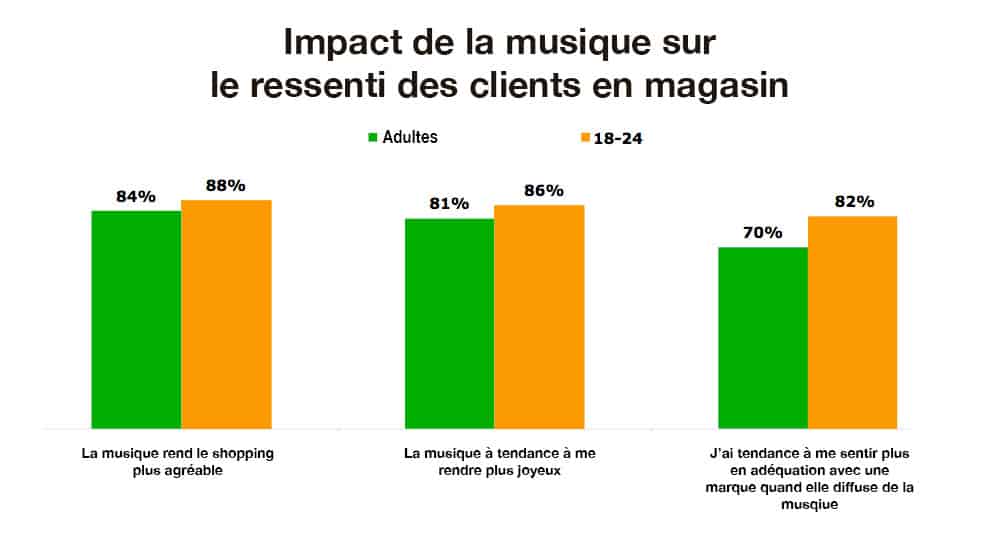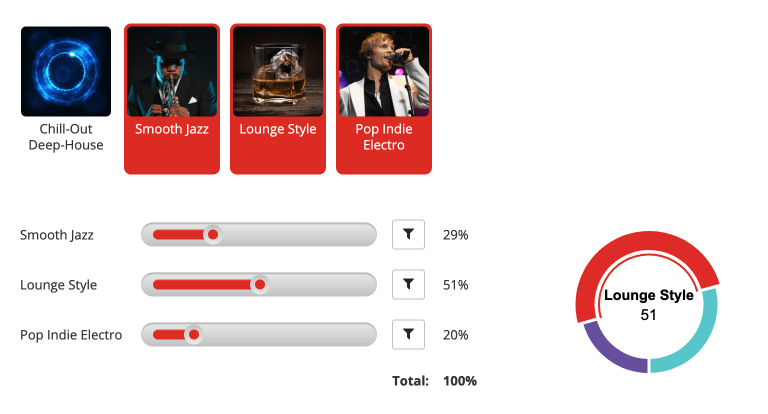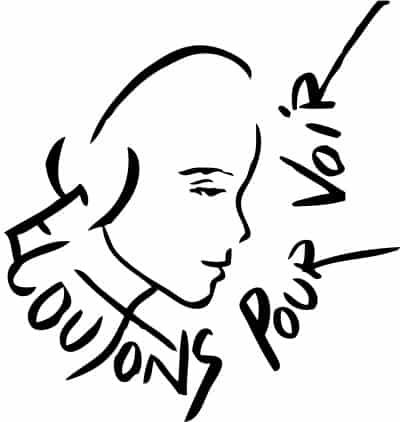A STRONG IMPACT
In-store ambient music should be inspired by quantitative web marketing, for a musical atmosphere that delivers a solid impact.
If you are familiar with Internet marketing, you know the A/B test system which aims to improve web pages by successive increments. At Écoutons Pour Voir, we believe that the same method should be applied to the musical atmosphere in the store, in order to determine a radio that is optimized according to real data collected in the field, and not according to a purely arbitrary definition of what customers should listen to.
The sensory approach
Among the competitors of our Music Admix in-store radio system, some offer to the customer to make his own radio. Others provide ready-made playlists, with the customer being responsible for choosing the one that suits him according to his mood or his idea of what his customers want to hear.
Some presentations made by our competitors are not lacking in panache : they present musical styles and associate marketing concepts with them. If your brand markets designer furniture, you will be eloquently told about the genres and instruments that encourage consumers to think design : a modern electro-pop with a medium tempo and electronic instruments around a learned orchestration, interspersed with warm recordings that leave room for the human.... they will even music samples to explain and reinforce the idea that certain music creates certain atmospheres.
It is not untrue to say that certain types of music correspond to certain feelings and lead to certain behaviours. some studiesfast tempo music tends to speed up movements, thus reducing the time consumers spend in stores, or slow music tends to displease younger customers. It is also known that older customers prefer background music in the background, while younger consumers prefer a more present and prominent store sound environment. It also seems quite obvious that ethnic music or music whose belonging to a specific cultural group must be used with caution depending on the context of the store.

The clichés to avoid
There are also some clichés that should be avoided. A company that provides in-store music service in the United States explains on its website that"...". if you sell high-end products, the best musical choice will be jazz or classical music, based on the image and style that the brand wants to convey in the minds of its customers. At Écoutons Pour Voir, we believe that this is a ready-made idea that can only serve the brand.
Why should we avoid such clichés? Because they are dangerous for the brand. They are based on preconceived ideas that associate music with a SPC or an atmosphere, without any evidence of the reality of this association. Most companies that supply music in stores rely on surveys conducted by SACEMFor example, a study very often cited as "a study of the music industry", which has only a limited general scope, or on studies, some of which are more than 15 years old, at a time when the way of consuming and living music was totally different. in-store music influences the choice of products "Another even more well-known study, on the influence of music in supermarketswas built in 1982, almost 40 years ago. How can such results still be used?
The same website of our American in-store music supplier continues:
« One study looked at the impact of music on wine sales and Christmas products, and the results suggest that when the store distributes classical music rather than Top 40 music, customers tend to choose quality wines, while a second study showed that when Christmas music is distributed, customers buy more Christmas-related products.
Problem, the study on wine, entitled" The influence of in-store music on the choice of wines "was published by A. North and D. Hargreaves in April 1999 in the Journal of Applied Psychology, more than twenty years ago. 20 years is enormous for modern marketing. 20 years later, we have seen the notion of customer journey and commitment appear, we have seen the Internet explode with the massive emergence of e-commerce and the weakening of the position of stores" brick and mortar "We have seen the emergence of Amazon's domination, the increase in home deliveries and relay packages, the way people consume music with sites like Spotify or Apple Music, etc. How can we still rely on scientific results from another era?
Moreover, we can make scientific studies say what we want to say, because they generally refrain from giving anything other than trends, which is what leads our American colleague to indicate that". Some believe that the Top 40 is better suited to teenagers and encourages them to spend more. Others argue that playing well-known music can encourage customers to leave the store because they hear it frequently: such playlists seem boring and reduce shopping pleasure.
On what basis are such recommendations based? On other studies dating back to Methuselah? On the personal advice of the marketing department? On an experience that cannot be measured and not measured? Thus, Let's listen to Pour Voir has been playing music in stores for 25 yearsWe do not broadcast the same playlists today as 25 years ago, or even 10 years ago; not only in terms of titles - which is obvious - but also because the structure of playlists has evolved, and because our diffusion system This is because consumer taste has evolved, technology has evolved, and point-of-sale marketing is evolving, and of course our experience is often very useful in creating a musical framework, but this experience would be of little interest if it were not based on feedback to measure the playlist's performance.
The quantitative approach
Such measurements are made possible by SaaS tools such as Music Admix, which generates playlists from a server, and by its cloud-based design, Music Admix generates A/B tests to determine whether or not the playlist is performing well, in other words, we do the work done by scientists in short-term studies such as the wine study mentioned above at the actual store level. a dedicated page on A/B split tests.
How does it work? the principle is simple: for a given page, for example the homepage of the website, two different versions are built, if you wish, you can opt for a simple test: during the first iteration, these versions will then be quite different and the variation will only concern one detail, but you can also opt for a multi-variant test, which will make the page presented vary quite deeply. it is the multi-variant approach that is now preferred by online marketers, for efficiency reasons. in
The performance of each of the two versions is then measured using the chosen indicator, or a combination of these indicators, such as reading time (time spent on the page), conversion rate, number of clicks or heatmap analysis, etc. The page that wins the test is then promoted and the other one is archived.
We then create another version of the page, which is generally based on the promoted page but adds some modifications. And then we start the test again. The winning page is then promoted, etc.
In some cases, we will check the page's performance after several iterations, by taking the page that lost the first test again: if all goes well, it loses it again and the difference in the conversion rate between the new version and this old version must be quite significant.
In the end, we obtain an optimized page thanks to a real performance measurement, in other words, we have figures that tell us which page is performing better than the other one, which is an important element, because in a world driven by data we can no longer afford to do blind marketing.
Blind marketing is about designing a web page, adjusting colors, images, text according to the desires or vision of the marketing team or designer in charge, then publishing everything and considering that the work is done, not testing the page, not asking users for their opinion, not measuring performance, but blind marketing is suboptimal, not working effectively, not taking risks.

Our position at Listening To See is that we must help our retail customers to perform better by using the best web technology for marketing.
How to proceed
How do we proceed? first, we learn about the brand's territory from the elements provided by the customer, which is defined by a series of information such as product characteristics sold and what they bring to consumers - a particular benefit, a result obtained, etc. The brand territory is also defined by the authority of the brand We also take into account emotional and psychological factors: consumers' perception of the brand Finally, we examine the symbolic significance of the brand Semantic and visual associations, possible archetypes.
These elements will give us a perception of brand identity, according to which we will combine different sound atmospheres, based not on types of music, but on a sequence of titles that aim to create a particular atmosphere.

Thus, for a modern luxury clothing brand for men, we could integrate titles from Lounge Electro which will be followed by titles from Rock Indie, a few titles from Soul and RnB, a bit of Dance in a flexible rhythm, all sprinkled with Deep House a bit jazzy, all of which will be worked on in order to create a unique atmosphere that will constitute our A radio.
We then design a second radio, which will draw on some similar elements but will add others: it could be a few titles from the 2000s that have become essential, remixes of French songs, or a sweeter Lounge, while we delete Soul; RnB and Dance, so this radio B will be different from radio A, while sharing a certain number of titles.
We then broadcast radio A in half of the network's stores, and radio B in the other half.
The first step in the measurement is to obtain feedback from the sales force after a few days. We obtain it either by an online questionnaire on the store's radio, It is useful to interview several people at this stage, as opinions differ quite widely according to their tastes and impressions.
If possible, we also collect consumer opinion Staff can ask customers for their opinion, by providing them with the URL of the online form (barcode, short URL etc.) or by implementing the query on a touch pad, or by setting up posters at the exit of the store, explaining that new music is being tested, and requesting feedback on social networks, for example in a form such as". If you like our new music, tell us by tweeting with the following hashtag.
The next step, which is optional if the difference in perception is significant, is to invert the two radios A and B in the test stores, before collecting again the feelings of the sales force and possibly customers. in most cases, we manage to extract qualitative as well as quantitative opinions, because in the opinions collected the sales force does not hesitate to share its personal opinion with us.
From this stage, we select one of the two radios, the A or the B, and we refine it according to the criteria that we are given.
This new version is then put into competition in the stores against the version that won the previous duel, which must first be agreed with the brand's marketing or communication department. the best way to measure the impact of musicWhat is important is that the object measured is quantifiable and can be cleared of interfering signals, for example, if store attendance usually decreases in the early part of the week.
Once the information is gathered, we analyse it and determine which of the two radios wins the duel, which then becomes the new radio A. We then set up a second radio B, which derives from radio A but makes changes, either according to the feedback received or according to the possibilities offered by the music catalogue, while remaining faithful to the brand territory, this second radio is set up without interruption because Music Admix there is never any interruption of the broadcast but simply switching from one radio to another.
Thanks to a series of steps like these, we succeed in obtaining the radio, if not the ideal one, at least optimized and which corresponds to the brand's expectations, satisfies the sales force and above all pleases the end customers. This radio is designed using numbers, according to a rational and measured process It's not blind marketing as is too often the case in the world of sound design.
To clear a real R.O.I.
It is easy to understand that this service has a cost: it requires a considerable effort, both on the part of the Listening to See teams and on the part of the brand. It therefore requires real involvement and an adequate budget. The payback is worth it, and the ROI (return on investment) is demonstrable over time because the music thus defined allows the store to perform better, by directly impacting the customer experience and feeling, and by influencing the sales path in a measurable way.
Are analytic and quantitative sound marketing inaccessible For brands that do not have such a budget? by necessity. Music Admix was indeed designed from the beginning to provide tools to measure effectiveness, so Let's Listen To See can create a store radio designed around several particular atmospheres, always according to the brand's indications. each of the atmospheres takes a certain part in the final broadcast.
For example 25% from Lounge Jazzy, 25 % from Lounge Electro, 30% from Pop Indie, 15% from Electro and 5% from Rock Indie, this radio, which represents radio A, can then be duplicated by the customer, who takes control of the system and can vary the proportions of each atmosphere, even add unused styles or remove styles, for example, the customer can reach 10% from Lounge Jazzy, 15% from Lounge Electro, 25% from Pop Indie, 151

After a few days or weeks, the customer can evaluate the relevance of each of the two radios according to the indicators he determines, then determine who is the winner of the duel and then proceed to create a new radio that modifies the previous settings to achieve a new iteration to refine the sound marketing. It is up to the marketing or communication department to determine the scope and duration of this campaign A/B test, as well as the measurement elements collected from the network, but the cost of this approach is measured only in time spent and has no impact on the Music Admix subscription rate.
Of course, the A/B test approach to sound marketing is not exclusive to Music Admix: if your in-store music supplier offers a tool that allows you to set up two different radios continuously over several stores in a few clicks, you have the possibility to set up a sound marketing driven by quantity, and no longer by a DJ's mood or questionable perceptions from outdated scientific studies, this is the minimum to expect, at a time when the quality of interactions between the brand and the consumer has become a fundamental element of
